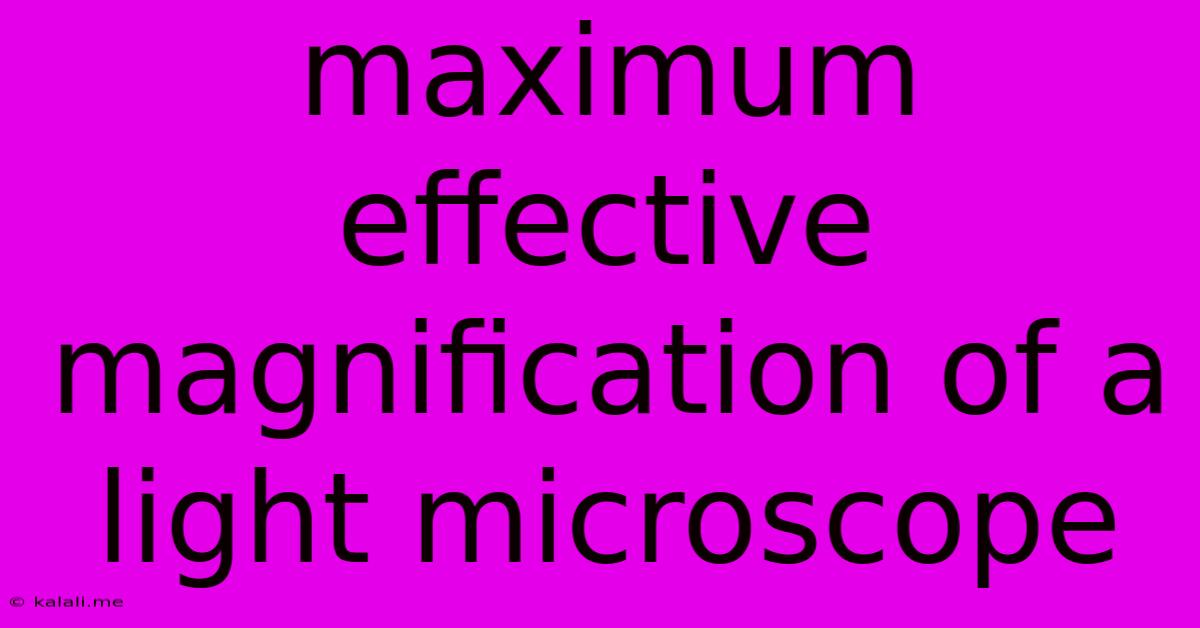Maximum Effective Magnification Of A Light Microscope
Kalali
May 21, 2025 · 3 min read

Table of Contents
Maximum Effective Magnification of a Light Microscope: A Comprehensive Guide
Meta Description: Discover the limitations of light microscopes and understand the concept of effective magnification. Learn how resolution, numerical aperture, and wavelength impact the maximum useful magnification you can achieve. This guide explains how to optimize your microscope for clear, detailed images.
Light microscopy is a fundamental tool in various scientific fields, enabling visualization of microscopic structures and organisms. However, there's a limit to how much you can effectively magnify an image using a light microscope. This article delves into the concept of maximum effective magnification, explaining the factors that determine it and how to achieve optimal image quality.
Understanding Resolution and Magnification: The Key Difference
Before discussing maximum effective magnification, it's crucial to distinguish between magnification and resolution. Magnification simply refers to the enlargement of an image. You can magnify an image infinitely, but it won't necessarily reveal more detail. Resolution, on the other hand, refers to the ability to distinguish between two closely spaced objects as separate entities. A high-resolution image shows fine details, while a low-resolution image appears blurry. Effective magnification is intrinsically linked to resolution; increasing magnification beyond the resolution limit only produces a larger, blurry image.
The Resolution Limit: Diffraction and the Abbe Equation
The resolution of a light microscope is fundamentally limited by the diffraction of light. Light waves bend as they pass through the lens system, limiting the ability to resolve fine details. This limit is described by the Abbe diffraction limit, given by the following equation:
d = λ / (2 * NA)
Where:
dis the minimum resolvable distance between two points.λis the wavelength of light.NAis the numerical aperture of the objective lens.
The numerical aperture (NA) is a measure of the lens's ability to gather light. A higher NA means the lens can gather more light and resolve finer details. The wavelength of light is also a crucial factor; shorter wavelengths (e.g., blue light) lead to better resolution than longer wavelengths (e.g., red light).
Calculating Maximum Effective Magnification
The generally accepted rule of thumb for maximum effective magnification is approximately 1000x the NA of the objective lens. This means that exceeding this magnification will not yield any significant increase in detail and will only result in an enlarged blurry image. For example, an objective lens with an NA of 1.4 would have a maximum effective magnification of around 1400x. This includes the magnification provided by the eyepiece.
Factors Affecting Effective Magnification: Beyond Resolution
While resolution is the primary limiting factor, other factors can influence effective magnification:
-
Lens Quality: High-quality lenses with precise manufacturing are essential for achieving optimal resolution and minimizing aberrations. Aberrations, such as chromatic aberration (color fringing) and spherical aberration (blurring due to imperfections in the lens curvature), degrade image quality.
-
Specimen Preparation: Proper specimen preparation is crucial. Techniques like staining can improve contrast and visibility, making it easier to resolve details at higher magnifications.
-
Illumination: Appropriate illumination techniques, such as Köhler illumination, are critical for achieving optimal image quality.
-
Microscope Type: Different types of light microscopes, such as bright-field, dark-field, phase-contrast, and fluorescence microscopes, have different capabilities and may affect the effective magnification achievable.
Optimizing Your Microscope for Effective Magnification
To maximize the effective magnification of your light microscope, consider the following:
- Choose high-NA objective lenses: Higher NA lenses provide better resolution.
- Use shorter wavelength light: Blue light offers better resolution than red light.
- Ensure proper illumination: Employ techniques such as Köhler illumination.
- Maintain your microscope: Regularly clean and calibrate your microscope for optimal performance.
- Utilize appropriate imaging techniques: Select the correct imaging technique for your specimen and desired level of detail.
By understanding the principles of resolution, numerical aperture, and wavelength, you can effectively utilize your light microscope to its full potential, achieving clear and detailed images at the maximum effective magnification. Remember, increasing magnification beyond the resolution limit only results in empty magnification – a larger, but not more informative, image.
Latest Posts
Latest Posts
-
How Many Planets Are In No Mans Sky
May 21, 2025
-
What Are You Up To Now
May 21, 2025
-
How Long Does It Take Tile Grout To Dry
May 21, 2025
-
How To Plug A Guitar Into A Pc
May 21, 2025
-
Fixing Heavy Shelves To Plasterboard Walls
May 21, 2025
Related Post
Thank you for visiting our website which covers about Maximum Effective Magnification Of A Light Microscope . We hope the information provided has been useful to you. Feel free to contact us if you have any questions or need further assistance. See you next time and don't miss to bookmark.